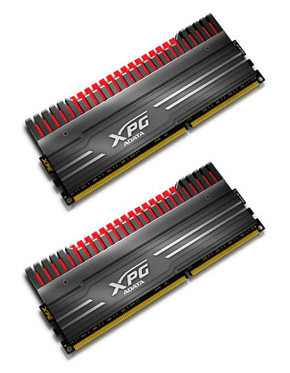Adata Releases its 3100 MHz XPG V3 Overclocking Memory
Adata has released some new memory, and it is very, very speedy.
Adata has launched some new RAM – the XPG V3 DDR3 overclocking memory. The memory is built to be super speedy and very durable, and to be used in conjunction with an Intel Z97 series motherboard.
Out of the box, the fastest kit is rated to reach speeds of up to 3100 MHz. Of course, skilled overclockers might be able to take this a bit further, but the XMP profile should do the work for you up to 3100 MHz. Kits will be available with various frequencies, where the lowest speed will be 1600 MHz. Timings vary from CL9 through CL12, depending on the frequency, and the memory will only come in kits of either 2x 4 GB or 2x 8 GB.
The PCBs of the memory modules are eight layers thick and have a 2 oz copper design. They also come with very big heatsinks, which ensure that all the chips are cooled sufficiently. For enthusiast overclocking with LN2, these can be removed.
No word on pricing or availability yet, but expect these to range from perfectly reasonably priced to absurdly expensive as the chosen frequency goes up.
Follow Niels Broekhuijsen @NBroekhuijsen. Follow us @tomshardware, on Facebook and on Google+.
Get Tom's Hardware's best news and in-depth reviews, straight to your inbox.
Niels Broekhuijsen is a Contributing Writer for Tom's Hardware US. He reviews cases, water cooling and pc builds.
-
Matthew Busse Flagship or extreme products generate excitement and brand recognition, and is coolReply -
rishiswaz ReplyBut why?
because reasons
That is a good enough for me, DDR3 3500 next, probably will have a CAS latency of 15 out of the box though -
Ryangrant Can someone explain to me how this ram can be utilized? for instance lets take the i7 4770k CPU, it can support 1600mhz ram speeds and 32gb max.Reply
This ram runs at 3100mhz but the cpu only supports 1600mhz. Where does the 3100mhz get utilized? Is there a way to OC the CPU to go from 1600mhz threshold to 3100mhz? I always thought if you are going to buy ram you should check what the CPU can support and not buy above it, as its not being utilized? If someone can explain where the ram speed comes into play if a CPU has max limit that is much lower than the rams speed that would be great.
see specs: http://ark.intel.com/products/75123/Intel-Core-i7-4770K-Processor-8M-Cache-up-to-3_90-GHz -
xenol ReplyCan someone explain to me how this ram can be utilized? for instance lets take the i7 4770k CPU, it can support 1600mhz ram speeds and 32gb max.
You can overclock the memory controller too.
-
Ryangrant Reply13784389 said:Can someone explain to me how this ram can be utilized? for instance lets take the i7 4770k CPU, it can support 1600mhz ram speeds and 32gb max.
You can overclock the memory controller too.
yes but if the CPU can only process 1600mhz of speed then when is the 3100mhz speed being utilized? How do you stuff more speed into the CPU's processing if its limited to 1600mhz? if by 'overclock the memory controller' you mean up the speed that the CPU's limit is set at then that makes sense, but can a 1600mhz CPU OC the memory controller input from 1600 to 3100 without issues? the point im missing is where does this ram actually get utilized? what hardware combinations would be able to use it's potential? If the CPU can't read above 1600 speed, then what applications can you use that would take advantage of a memory controller running at 3100?
You have to forgive me as it's been a long time since I've studied the theory of computer hardware/systems and don't quite remember about how the motherboard components individually interconnect and where you could OC one thing and actually see a difference vs OCing a component and not seeing any difference due to limitations on the CPU or other areas.

